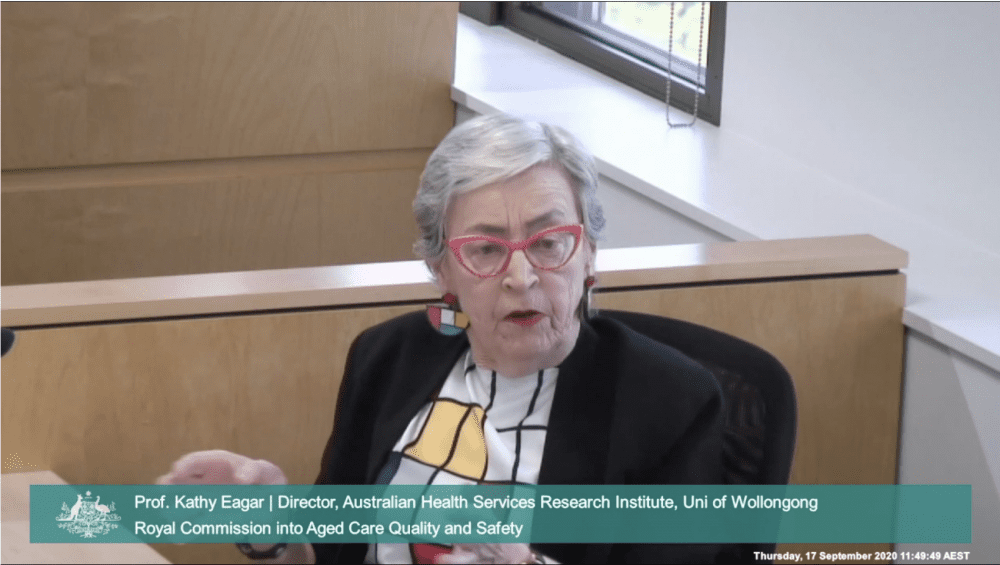
Australia’s aged care system is “totally inequitable” because the wealthy do not make a larger contribution to the costs of the services they use as they age, the royal commission has heard.
The former Chair of the Aged Care Financing Authority, Mike Callaghan, told the commissioners most Australians “don’t spend the money they have in retirement”.
“People with assets they have going into retirement, when they die they haven’t dipped into them. And there’s very large growth in inheritances.” he said.
“Instead of that growth in inheritances, people should be using the assets, when they have them, they should be using more of those assets to fund the range of goods and services that they need as they age,” he said.
Mr Callaghan said former prime minister Paul Keating’s HECS-style funding proposal for aged care required “consideration”, but he said tax avoidance is already a big problem in estate management.
He said the commissioners should consider drawing on the value of the home to fund age care as a means to fund aged care services.
Australian Health Services Research Institute Director, Professor Kathy Eagar, also appeared before the royal commission on Thursday.
Professor Eager was co-author of the 2019 report ‘Resource Utilisation and Classification Study’, an examination of Australia’s aged care classification system.
She said aged care should not be separated from the rest of a person’s life and treated as a silo.
“There’s a set of issues about what does this person need and want, what are their strengths, what are their preferences, what’s their appetite for risk, what are the set of services we can wrap around a person in order for them to live independently in the community, and within that subset, which of those should the Commonwealth subsidise,” she said.
Professor Eagar said she would like to see a larger range of accommodation options for ageing Australians.
“I would actually want to see both smaller homes into the future and more specialised homes,” she said. Professor Eagar said there was also the opportunity to reinvent the ‘community hospice’ model, for “someone who’s living alone, has a limited time to live, doesn’t need to be in hospital but doesn’t want to die at home.”
Professor Eagar proposed that the aged care system be redesigned into four streams with different funding models and simultaneous access.
The four streams are: age-friendly community services, primary aged care services, secondary aged care services and tertiary aged care service.
“These are not Commonwealth funding programs in the way we have them now. In my model, a person can be accessing services on each of these streams simultaneously,” she explained.
“So somebody can be in residential care and still accessing community services or a community transport service with their carer.”
The primary, secondary and tertiary streams include both ongoing and episodic care streams, Professor Eagar told the commission.
The primary aged care services stream includes: house cleaning, community buses, someone to help you make the bed, and laundry services, for example. The episodic primary care stream would include, for example, short-term help with personal care and wound dressing.
The secondary stream is for people living at home with higher level care needs and covers the hands-on personal care that would follow an ACAT assessment. It would include services such as allied health and dementia support. Episodic care in this stream would include, for example, restorative care enabling programs.
The tertiary aged care service stream is similar to the current residential aged care model and is for those who are unable to live at home. It would include residential care, cluster housing and community hospice care. The episodic tertiary care stream would include residential respite services and transition care.
During Thursday’s hearing, royal commissioner Tony Pagone announced the commission would issue a special report on the COVID-19 pandemic in aged care by 30 September.
The report “will contain specific recommendations from us to expedite and facilitate the implementation of comprehensive measures to protect older Australians during this time,” Commissioner Pagone said.
Royal commission hearings into ‘Funding, financial and prudential regulation’ will continue until Tuesday next week.
In many ways I agree with this concept. However – I have no confidence that the extra funding provided by more wealthy people paying more for their aged care would lead to anyone’s care being better. As soon as more funding comes into the system it is gobbled up – and in many cases put into shareholders’ pockets. Unless aged care comes back into the not-for-profit sector and is properly funded by governments first and foremost, any improvement of services by charging wealthy clients more is just a pipe dream.